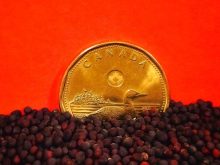CNS Canada — The Canadian dollar has been steadily depreciating through 2015, sinking to an 11-year low relative to its U.S. counterpart as the end of the year creeps closer.
Even if the loonie stays weak in 2016, however, two analysts expect the upside potential it brings to agricultural commodity markets has mostly run out.
“Historically speaking, I have considered the effect of currency in determining price a secondary issue, but for 2015 I would say it’s been a primary issue — especially considering the rapid deterioration that we’ve had,” said Mike Jubinville of ProFarmer Canada.
Read Also

U.S. grains: Soy futures set 15-month high after China agrees to purchases
U.S. soybean futures reached a 15-month high on Thursday after President Donald Trump’s administration said top-importer China agreed to buy tens of millions of tons of American crops in the next few years as part of a trade truce.
A weak loonie has allowed Canadian grains and oilseeds to be priced more competitively in international markets throughout the year.
But even if the loonie stays low, Jubinville said, the direct impact to commodity prices has likely already been baked in. “I wouldn’t expect any significant price changes in agricultural commodities.”
That means the influencers at play in the new year will likely be wrapped around politics, weather and economic issues outside of currency markets.
A weaker loonie, however, still has the potential to drive up farmers’ costs of production. Fertilizer and machinery, which primarily come from the U.S., are more expensive because of the low Canadian dollar.
Jubinville said he expects the loonie to stay between US72 and 78 cents in the year ahead, but cautioned that currency markets are hard to predict.
A key U.S. Federal Reserve meeting on Wednesday (Dec. 16) is also a potential source of turbulence. Many analysts anticipate the Fed will raise interest rates, creating an even more bullish environment for the U.S. greenback.
“But I think the trade has already got that boost of interest factored into the current currency dynamics out there,” Jubinville said.
Whether the Canadian dollar will depreciate further in 2016 is heavily linked to what crude oil futures do.
Crude oil markets face a significant amount of uncertainty as the Organization of Petroleum Exporting Countries (OPEC) removed the ceiling on production, allowing an already oversupplied market to grow.
Ken Ball, a broker at PI Financial Corp., doesn’t think the loonie’s plight will be as dramatic in 2016. He said he thinks the dollar is near a low.
“I don’t think from here on out you’re really going to get the kind of movement that we’ve had the last couple of years.”
Ball agreed support from a weaker loonie to commodity markets won’t drive prices dramatically higher in 2016.
“It can still provide some support just by staying low, but perhaps we won’t get any new incremental support, at least not as much in 2016.”
The Canadian dollar fell this month to an 11 1/2-year low, sitting around US73 cents Tuesday, down from US86 cents a year ago and US94 cents a year and a half ago.
— Jade Markus writes for Commodity News Service Canada, a Winnipeg company specializing in grain and commodity market reporting. Follow her at @jade_markus on Twitter.












